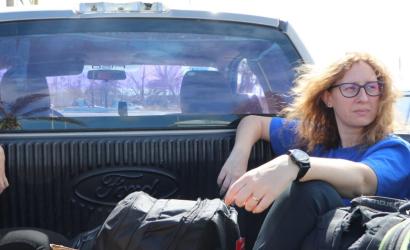The Bahamas
The Bahamas is an archipelago in the Caribbean region of over 700 islands with an estimated population of 389,482. The islands are vulnerable to storms and floods during the annual hurricane season from June to November, frequently impacting on its people. The capital and largest city is Nassau, with a population of 255,000. The Bahamas can refer either to the country or to the larger island chain that it share with the Turks and Caicos Islands. The official language of the Bahamas is English and many people speak English-based creole. Haitian Creole is spoken by Haitians who make up approximately 25 per cent of the total population.
On 1 September, Hurricane Dorian - a category 5 hurricane - made landfall on the northern islands of the Bahamas and a second landfall on Abaco island as the strongest hurricane in the Bahamas' history, causing extreme flooding as well as power and connectivity outages. At least five people have been killed as Hurricane Dorian continues to move westward over Grand Bahama at approximately 1mph, stalling over the island.
WFP has deployed one staff member to the Bahamas to support initial assessments which are expected to start on 4 September, coordinated by the Caribbean Disaster Emergency Management Agency (CDEMA). A number of ETC partners are currently in Barbados conducting a training exercise for CDEMA. Some of these partners will be deployed to assist response efforts in the Bahamas. The Crisis Connectivity Charter is being activated to ensure satellite equipment is readily available in the most affected areas to support initial response efforts.
Contacts
National Emergency Management Agency (NEMA) EOC
Address: Gladstone Rd, Nassau
Contact: +1(242) 322-6081
TELCO focal points
BTC - Brian Jacques +1(242) 4570178
Aliv - Julian Dean +1(242) 816-7583
Humanitarian responders on the ground
Caribbean Disaster Emergency Management Agency (CDEMA), Caribbean Public Health Agency (CARPHA), Global Affairs Canada (GAC), Pan American Health Organization (PAHO), Port Managers Association of the Caribbean (PMAC), International Federation of Red Cross and Red Crescent Societies (IFRC), Office for the Coordination of Humanitarian Affairs (OHCA), World Food Programme (WFP), Map Action, Pacific Disaster Centre (PDC), UK Department for International Development (DFID) and the US Coast Guard.
ICT Profile
National Emergency Management Agency (NEMA)
Department of Information Technology (DIT)
Utilities Regulation and Competition Authority (URCA)
385,640
Source: World Bank 2018
The Bahamas is comprised of 700 islands in the western Atlantic Ocean, just to the south east of Florida, and north east of Cuba. The Bahamas is exposed to a similar range of natural hazards as much of the remainder of the Caribbean region, including hurricanes sourcing from both the Atlantic Ocean and the Caribbean Sea. In addition to wind hazards, many coastal areas are vulnerable to storm surge and wave damage. The islands are also subject to earthquake risk, though at a low level and related to earthquake source zones to the south.
Source: CCRIF
2.2 (low)
Source: INFORM Risk 2019
+1242
.bs
Voltage: 120V, Frequency: 60Hz, Plug type: A, B
No
No
None
29.4
Source: ITU ICTeye 2017
99
Source: ITU ICTeye 2017
20.8
Source: ITU ICTeye 2017
60.8
Source: ITU ICTeye 2017
70.3 (medium-high)
Source: GSMA Intelligence 2017
99
Source: GSMA Intelligence 2017
This describes some of the regulations and rules related to the use of emergency telecommunications equipment in the Bahamas.
The enactment of Chapter 34A Disaster Preparedness and Response Act in 2008 set the basis for the current normative framework for disaster management in the Bahamas, consolidating National Emergency Managment Agency as the national agency responsible for disaster relief management in the country.
An Act to create a new legal regulatory framework for telecommunications in The Bahamas to remove monopoly rights of The Bahamas Telecommunications Corporation and to establish a licensing regime for telecommunications. 1. This Act may be cited as the Telecommunications Act.
Not a signatory to the Tampere Convention.
According to the Bahamas’ national aviation authority, the Bahamas Civil Aviation Authority (BCAA), flying a drone is legal in the Bahamas. Drone regulations should be complied with.
Submarine cable landing station (CLS)
Point of landing: Freeport (Bahamas)
Ready for service: In development
Total Length: 2,500kms
Design Capacity: Initial 40Gb/s, Upgradeable to 100Gb/s
Owners: Global Nexus Telecommunications Ltd
Website: https://www.globalnexus.com/cable-map/
Bahamas Internet Cable System (BICS)
RFS (ready for service): 2001
Cable Length: 1,100 km
Owners: Caribbean Crossings
URL: http://www.caribbeancrossings.com
Bahamas Domestic Submarine Network (BDSNi)
Email link
RFS: 2006
Cable Length: 2,817 km
Owners: Bahamas Telecommunications Company, Teleco
URL: http://www.btcbahamas.com
EWS system(s) in place? - Yes
NEMA has installed a severe weather warning siren system throughout the Bahamas.
Managed by the National Emergency Management Agency (NEMA)
Iridium - Yes
Thuraya - No
Inmarsat - Yes
Globalstar - Yes
